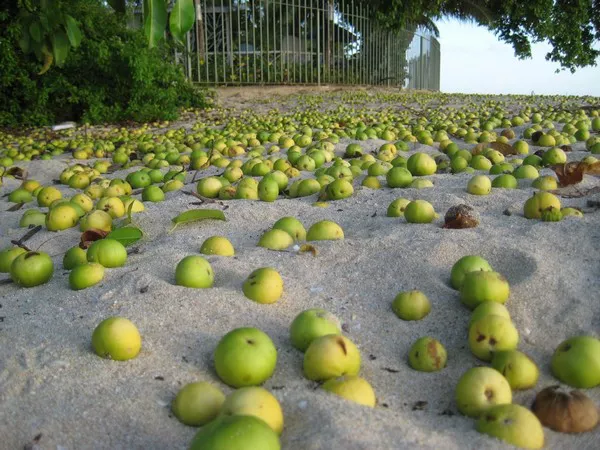Trees, often perceived as symbols of life and environmental well-being, can also harbor concealed dangers. In this article, we embark on a journey into the arboreal world to uncover the top 10 dangerous and occasionally deadly trees. Each entry is meticulously researched, providing a well-founded understanding of these seemingly innocuous yet perilous botanical entities, their toxic components, and the potential risks they pose to humans and ecosystems.
Top 10 Dangerous (& Sometimes Deadly!) Trees
1. Manchineel Tree:
Standing proudly along tropical shores, the Manchineel Tree (Hippomane mancinella) hides a perilous secret beneath its glossy leaves and deceptively sweet fruit. Considered one of the most poisonous trees globally, every part of this tree contains a potent toxin called phorbol. From blistering rashes to severe digestive distress, encounters with the Manchineel demand caution. Understanding its coastal habitats and the risks associated with this toxic giant highlights the importance of awareness in regions where it thrives.
2. Castor Bean Plant:
Though not a tree in the traditional sense, the Castor Bean Plant (Ricinus communis) earns its place due to the deadly toxin ricin, found in its seeds. Widely distributed across the globe, this plant’s seeds contain ricin, a potent protein that can be lethal even in small doses. Examining its widespread cultivation and industrial uses underscores the importance of recognizing its potential dangers.
3. Strychnine Tree:
Native to Southeast Asia, the Strychnine Tree (Strychnos nux-vomica) harbors the toxic alkaloids strychnine and brucine in its seeds. These compounds, notorious for causing muscular convulsions and respiratory failure, contribute to the tree’s lethal reputation. Exploring the historical uses and the potential risks associated with the Strychnine Tree reveals the need for caution in regions where this poisonous entity thrives.
4. Oleander:
Adorning gardens and landscapes with its vibrant flowers, the Oleander (Nerium oleander) conceals a dark side beneath its aesthetic allure. All parts of this ornamental shrub contain toxic cardiac glycosides, posing a severe threat to humans and animals alike. Investigating its widespread cultivation and the symptoms of oleander poisoning emphasizes the importance of recognizing and handling this common but dangerous plant with care.
5. Yew Tree:
Despite its historical significance and use in landscaping, the Yew Tree (Taxus spp.) is not as benign as it may seem. Its needles and seeds contain toxic alkaloids, such as taxine, which can be fatal if ingested. Unraveling the dual nature of the Yew Tree, appreciated for its longevity and cultural significance but feared for its hidden toxicity, sheds light on the importance of awareness in areas where it is prevalent.
6. European Spindle Tree:
The European Spindle Tree (Euonymus europaeus) captivates with its vibrant colors and ornamental appeal. However, its seeds contain toxic compounds, including alkaloids and cardiac glycosides. Understanding the potential risks associated with this visually striking tree reinforces the need for caution, especially in regions where it is cultivated for its decorative features.
7. Euphorbia Tree:
A diverse genus comprising various species, Euphorbia trees and succulents are renowned for their peculiar shapes and striking forms. Yet, their milky sap contains toxic compounds, including phorbol esters, that can cause severe skin irritation and even internal damage if ingested. Exploring the unique adaptations and potential dangers of the Euphorbia genus underscores the importance of handling these succulents with care.
8. African Blackwood:
Celebrated for its dense and dark heartwood, the African Blackwood (Dalbergia melanoxylon) holds a hidden danger beneath its exquisite appearance. The wood dust from this tree has been linked to respiratory issues, earning it a reputation as a potential health hazard for those involved in its processing. Examining the risks associated with the African Blackwood offers valuable insights into occupational safety in industries where this timber is utilized.
9. Suicide Tree:
Endemic to Southeast Asia, the Suicide Tree (Cerbera odollam) earned its ominous name due to the lethality of its seeds. Containing potent cardiac glycosides, the ingestion of even a small quantity of these seeds can lead to fatal consequences. Unraveling the cultural significance and the deadly potential of this notorious tree underscores the need for awareness in regions where it is native.
10. Wandering Tree:
Hailing from the forests of Central and South America, the Wandering Tree (Dieffenbachia spp.) captivates with its distinctive foliage. However, its sap contains oxalate crystals, causing painful irritation and swelling upon contact with the skin. Delving into the unique characteristics of this ornamental plant emphasizes the importance of cautious handling, particularly in households where it is cultivated for its aesthetic appeal.
See Also: 10 Most Poisonous Plants In The World
Conclusion:
In conclusion, the world of dangerous and occasionally deadly trees unveils a complex tapestry where beauty and peril coexist. From the toxic allure of the Manchineel to the insidious nature of the Suicide Tree, each entry demands respect and awareness from those who interact with trees in various environments. Understanding the botanical intricacies, ecological roles, and potential risks associated with these dangerous trees is crucial for promoting safety, conservation, and responsible interaction with nature. As we traverse the forest of hidden threats, a deeper appreciation for the nuanced relationship between humans and trees emerges, emphasizing the need for continued research, education, and environmental stewardship.
You Might Be Interested In:























